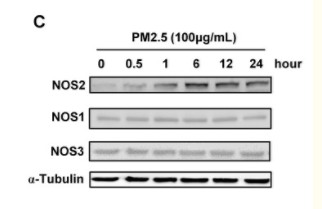Phospho nNOS (S852) Cell-Based Colorimetric ELISA Kit
- Catalog No.:KA1309C
- Applications:ELISA
- Reactivity:Human;Mouse;Rat
- Gene Name:
- NOS1
- Human Gene Id:
- 4842
- Human Swiss Prot No:
- P29475
- Mouse Swiss Prot No:
- Q9Z0J4
- Rat Swiss Prot No:
- P29476
- Storage Stability:
- 2-8°C/6 months
- Other Name:
- Nitric oxide synthase, brain (EC 1.14.13.39) (Constitutive NOS) (NC-NOS) (NOS type I) (Neuronal NOS) (N-NOS) (nNOS) (Peptidyl-cysteine S-nitrosylase NOS1) (bNOS)
- Detection Method:
- Colorimetric
- Background:
- alternative products:Isoform 3 is produced by different alternative splicing events implicating either the untranslated exons TEX1 (TN-NOS) or TEX1B (TN-NOSB) leading to a N-terminus truncated protein which possesses enzymatic activity comparable to that of isoform 1. The C-terminal truncated isoform 4 is produced by insertion of the TEX2 exon between exons 3 and 4 of isoform 1, leading to a frameshift and a premature stop codon,catalytic activity:L-arginine + n NADPH + n H(+) + m O(2) = citrulline + nitric oxide + n NADP(+).,cofactor:Binds 1 FAD.,cofactor:Binds 1 FMN.,cofactor:Heme group.,cofactor:Tetrahydrobiopterin (BH4). May stabilize the dimeric form of the enzyme.,disease:Genetic variations in NOS1 gene are associated with susceptibility to infantile hypertrophic pyloric stenosis type 1 (IHPS1) [MIM:179010]. IHPS has an incidence of 1-5 per 1'000 live births in whites and a marked preponderance of males to females (4:1). IHPS is the most frequent disorder requiring surgery in the first year of life. The disorder is characterized by hypertrophy and hyperplasia of the circular muscle layer of the pylorus, leading to persistent vomiting 2-12 weeks after birth. Defective pyloric relaxation and increased pyloric smooth muscle mass have been suggested to be responsible for gastric-outlet obstruction.,domain:The PDZ domain in the N-terminal part of the neuronal isoform participates in protein-protein interaction, and is responsible for targeting nNos to synaptic membranes in muscles.,enzyme regulation:Stimulated by calcium/calmodulin. Inhibited by n-Nos-inhibiting protein (PIN) which may prevent the dimerization of the protein. Inhibited by NOSIP.,function:Produces nitric oxide (NO) which is a messenger molecule with diverse functions throughout the body. In the brain and peripheral nervous system, NO displays many properties of a neurotransmitter.,online information:Nitric oxide synthase entry,similarity:Belongs to the NOS family.,similarity:Contains 1 FAD-binding FR-type domain.,similarity:Contains 1 flavodoxin-like domain.,similarity:Contains 1 PDZ (DHR) domain.,subcellular location:In skeletal muscle, it is localized beneath the sarcolemma of fast-twitch muscle fiber by associating with the dystrophin glycoprotein complex. In neurons, enriched in dendritic spines.,subunit:Homodimer. Interacts with DLG4; the interaction possibly being prevented by the association between NOS1 and CAPON. Forms a ternary complex with CAPON and RASD1. Forms a ternary complex with CAPON and SYN1. Interacts with ZDHHC23. Interacts with NOSIP; which may impair its synaptic location (By similarity). Interacts with HTR4.,tissue specificity:Isoform 1 is ubiquitously expressed: detected in skeletal muscle and brain, also in testis, lung and kidney, and at low levels in heart, adrenal gland and retina. Not detected in the platelets. Isoform 3 is expressed only in testis. Isoform 4 is detected in testis, skeletal muscle, lung, and kidney, at low levels in the brain, but not in the heart and adrenal gland.,
- Function:
- syncytium formation by plasma membrane fusion, regulation of neurotransmitter levels, response to hypoxia, arginine metabolic process, arginine catabolic process, nitric oxide biosynthetic process, regulation of muscle contraction,regulation of striated muscle contraction, syncytium formation, cell-cell signaling, synaptic transmission, myoblast fusion, regulation of heart contraction, cellular amino acid catabolic process, glutamine family amino acid metabolic process, glutamine family amino acid catabolic process, response to temperature stimulus, amine catabolic process,response to heat, response to abiotic stimulus, regulation of calcium ion transport into cytosol, negative regulation of calcium ion transport into cytosol, regulation of metal ion transport, myotube differentiation, organic acid catabolic process, transmission of nerve impulse, regulation of homeostatic process, negat
- Subcellular Location:
- Cell membrane, sarcolemma; Peripheral membrane protein. Cell projection, dendritic spine . In skeletal muscle, it is localized beneath the sarcolemma of fast-twitch muscle fiber by associating with the dystrophin glycoprotein complex. In neurons, enriched in dendritic spines (By similarity). .
- Expression:
- Isoform 1 is ubiquitously expressed: detected in skeletal muscle and brain, also in testis, lung and kidney, and at low levels in heart, adrenal gland and retina. Not detected in the platelets. Isoform 3 is expressed only in testis. Isoform 4 is detected in testis, skeletal muscle, lung, and kidney, at low levels in the brain, but not in the heart and adrenal gland.
- June 19-2018
- WESTERN IMMUNOBLOTTING PROTOCOL
- June 19-2018
- IMMUNOHISTOCHEMISTRY-PARAFFIN PROTOCOL
- June 19-2018
- IMMUNOFLUORESCENCE PROTOCOL
- September 08-2020
- FLOW-CYTOMEYRT-PROTOCOL
- May 20-2022
- Cell-Based ELISA│解您多样本WB检测之困扰
- July 13-2018
- CELL-BASED-ELISA-PROTOCOL-FOR-ACETYL-PROTEIN
- July 13-2018
- CELL-BASED-ELISA-PROTOCOL-FOR-PHOSPHO-PROTEIN
- July 13-2018
- Antibody-FAQs


